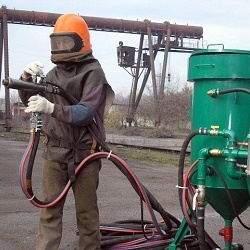Choosing a cultivator for soil
With the arrival of spring, the holiday season traditionally opens. Work in the garden requires a lot of physical effort and time, so experienced gardeners use auxiliary equipment to facilitate work. In agricultural work especially helps cultivator. The device is designed for efficient and fast tillage, and in large areas becomes an indispensable tool. In the article we will consider the main characteristics of this unit and give recommendations on how to choose the right cultivator to give.
Content
What is a cultivator
The cultivator is a device for quality ground care. Previously, cultivators were often used for production purposes, on large farms and agricultural areas. Now they are actively used at the household level - good, the choice has become just huge. The cultivator loosens the soil, removes weeds, forms even beds, aligns the surface of the soil and mixes the fertilizers qualitatively. This is not only a convenient replacement for an ordinary shovel, but also a great time saver. Cultivators are equipped star cutterswith the help of which plowing, loosening, aeration, hilling of the earth, etc. takes place. After cultivation, the soil becomes soft and ready for sowing.

The cultivator is easy to manage, if you know the features of its design and principle of operation. The internal design depends on the type of cultivator and the specifics of the work.
It is important to distinguish the cultivator from the motoblock. Motoblock is a self-propelled unit, it is versatile and more powerful. The scope of its application is extensive. The design of the tiller includes a motor, transmission, chassis, control panel.Cultivators (and cultivators) - more specific in functionality and easier to use.
The main components of any cultivator:
- frame;
- control handle, retractable;
- steel beams;
- 1,2 or 3 wheels;
- a rotor for connection of mills of different functional;
- brackets for mounting openers or other attachments;
- cultivating device;
- engine (electric, gasoline);
- tank for the gulf of fuel.
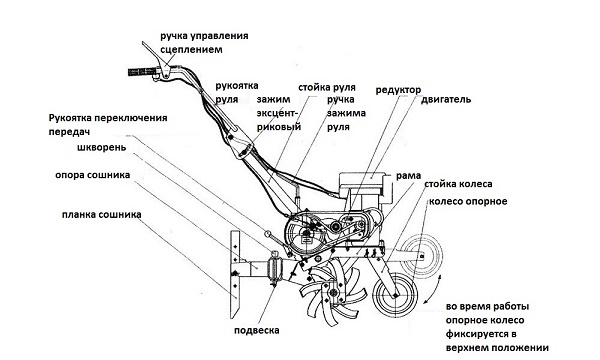
One person will cope with the majority of models without any help, even ultralight cultivators for women are developed. Manual cultivators will be useful in private homes for plowing homestead territory, care for small beds and flower beds. More technologically advanced and multifunctional units are designed to process several hectares of soil in the shortest possible time. In addition, farmers use cultivators for loosening, leveling the soil in greenhouses. Usually in greenhouses there is not enough free space, so a manual cultivator is definitely needed here.
Types of hinge plates
If you want to make the cultivator truly multifunctional, we recommend installing additional hinges on it. This equipment allows you to perform not only standard types of work such as plowing or loosening: with certain types of weights, you can spud the soil, plant and harvest potatoes, cut furrows, sow seeds. Some hinges are designed for tasks such as harvesting hay, cleaning garbage and snow. The use of attachments will save a lot of money, because you do not have to purchase separate equipment for various types of agricultural work.
Suspension can be divided into two types: active and passive. Active have moving parts that start to work with the help of a cultivator motor. The rotational energy of the engine is transferred to the linkage either with a belt drive or through a special PTO shaft. Attachments of the active type include a snow blower, various types of mowers, a sweeping brush. Passive linkages are not equipped with their own moving parts and come into action only from the movement of the cultivator itself. The most popular types of this type are the plow, hiller, potato planter, potato digger.
Consider the most useful and popular among farmers types of hanging.
Coupler
This is an auxiliary adapter element, which allows you to attach any attachments to the cultivator. Without a hitch, you are unlikely to install a plow or pile driver.
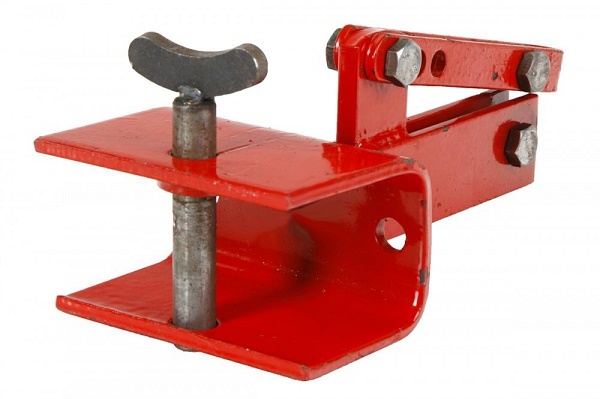
There are universal couplings, and issued for a specific brand of hinge. Typically, the hitch is installed at a time using mounting brackets. It is much easier to remove it, for this it is not necessary to use additional tools.
Hiller
An experienced farmer rarely works without it. The equipment facilitates the hilling of the soil, forms even ridges and earthen ridge. Most often the cultivator is equipped with special hiller for potatoes. It is used for cutting smooth furrows and digging up root crops during the harvest period. There are hillocks with plowshares, dumps (steel sheets) and disc, propeller type.Today in the agricultural sector are most in demand disc hillers, they are produced by most modern manufacturers. When performing its functions, this type of hiller meets much less resistance from the ground. As a result, the load on the equipment and the leading operator is reduced. By adjusting the settings when installing a disk hiller, you can form earth ridges of different heights. At the same time, the earthen ridges are more robust and stable than hillers with plowshares. The latter, when creating the crest, pour part of the earth back into the furrow.
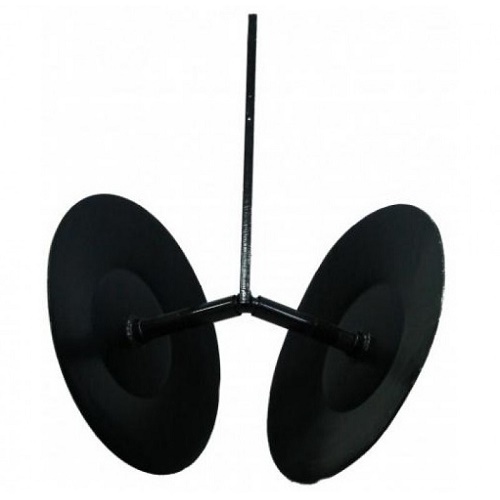
Disc hiller for cultivator
Plow
Used for virgin soil during plowing, when it is necessary to turn over large layers of earth. The hitch is installed through a hitch or a special adapter. Now summer residents use one of two types of plow: standard and negotiable. The usual plow in the course of work forms dump only in one party. The revolving part consists in turn of two plows, therefore, the dumps of the soil are carried out simultaneously on two sides. With the help of the second type of plow, it is possible to plow a large area of the site much faster and more efficiently.

Reversible plow
Potato Planter
Purchase of this sample will save you from the tedious and time-consuming procedure of planting potatoes. Sazhalka is a complex unit consisting of a small plow, a hopper with a shipping tape and a disc hiller. The plow forms a trench and prepares the soil for planting the root. Seed material is loaded onto the conveyor belt for planting. Compact hiller loosens the ground and sprinkles the planted material.
This equipment is productive, but expensive. However, potato planter fully justifies its price in the cultivation of a large number of hectares of land.
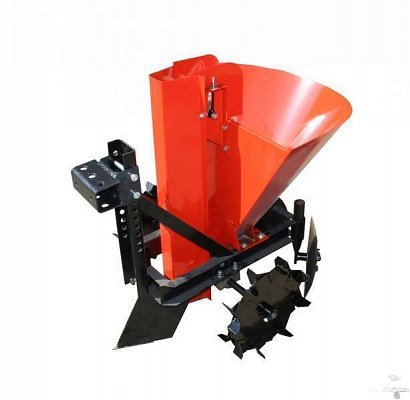
Potato digger
The main task of the linkage is harvesting. By design, it resembles a hiller, but instead of steel plowshares, it has long beams that resemble a broomstick. The principle of operation is simple: the rays dig up the surface of the soil, the soil is carefully sifted, and the pulled out roots are automatically thrown to the other side. Fastener hinge to the cultivator through the coupling.
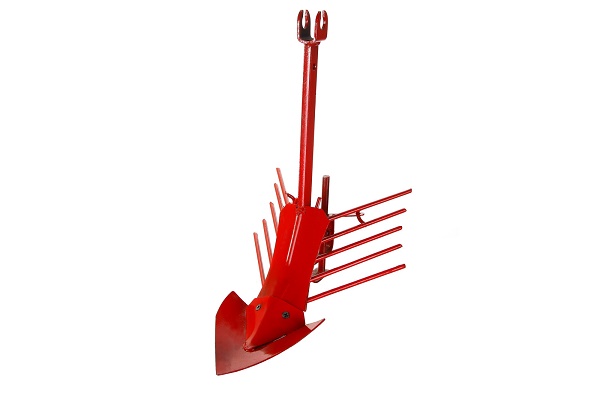
Zerosazhalka
As the name suggests, this linkage is used. for planting seeds. Available in two variations: 2-row sazhalka and 4-row. A hitch is a complex consisting of a seed bin, a calibration disk, and a small plow for cutting furrows. So that the planter does not slip, a steel grouser is installed at the back of it.
Cultivator classification
The abundance of garden equipment in specialized stores is confusing. It is difficult to immediately answer the question, which cultivator is best suited for the garden and at the same time cope with all the necessary amount of earthworks. There are several classifications of cultivators: by type of drive, engine and by weight.
By type of drive
In this segment, mechanical (manual equipment) and motorized equipment are separated.
- Hand cultivator. This is the easiest type of device. Thanks to him, you can gently cultivate the land in remote places and greenhouses, on small paths, in flowerbeds. The cultivator of manual type is small and mobile, does not require additional maintenance and consumables, inexpensive. Women and elderly people can easily cope with a mini cultivator of manual type.Unfortunately, it is not suitable for work on the virgin soil, stalled on clay soils.
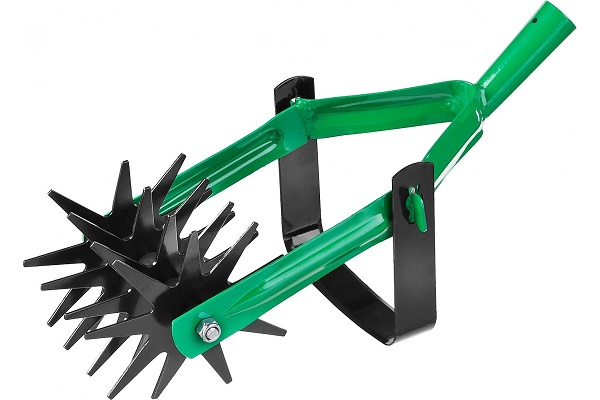
- Automatic (motor-cultivators). They are more expensive, but have excellent performance. Cultivators from the gardener require much less physical effort compared with manual-type devices. Work on fuel (eg, gasoline), from the battery and the network.
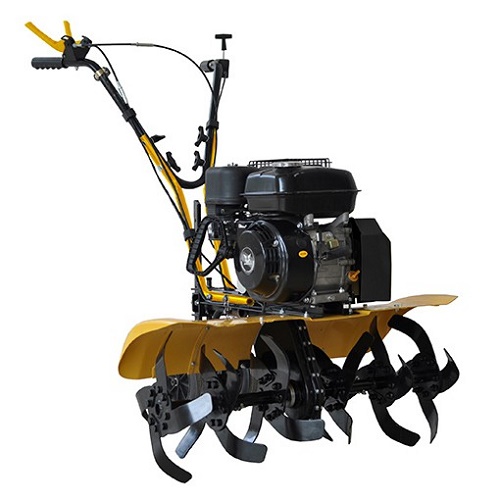
Motor-cultivator petrol Huter GMC-5.5
By type of engine
This classification applies only to motorized cultivators (motor-cultivators). Here you can select 4 types of engines.
- Petrol. This is a powerful and versatile device, primarily designed to work in large areas. The gasoline cultivator is multifunctional, it is unlimited in moving across the territory of the plot and is capable of working the soil at a great depth. The unit requires careful maintenance, fueling with high-quality fuel (strictly marked brands often approach a certain model of the cultivator). With large amounts of work with petrol models, expensive repair is often required (strong carbon is formed inside the engine, and the device gradually fails).However, all the costs of repairs and fuel pay off completely: you spend less physical effort and time, while handling huge areas. Ideal for professionals in the field of agriculture.
- Diesel motor cultivator. It has high tractive effort and is able to work for a long time at low revs. Effective when plowing, hilling the soil and cutting furrows. The diesel engine is more resource-intensive than the gasoline one. This increases its performance, gives a more effective result. True, a diesel engine cannot always work only at low revs: sooner or later a breakdown will occur, and the motor-cultivator will fail. Therefore, sometimes the engine must be loaded at maximum power for about 2-3 hours.
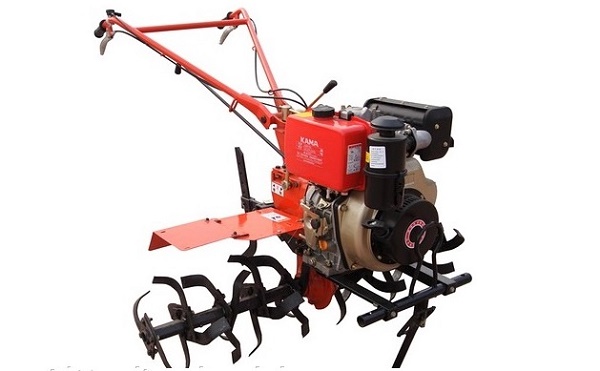
Cultivator diesel Forte HSD1G-1350
- Electric. Lightweight, mobile and compact, unlike the gasoline counterpart. The electric cultivator is mainly chosen for gardening, processing flower beds and small ridges. As the name implies, it works on the electrical grid, and therefore does not harm the environment. Prost in service and operation, does not demand additional expenses on fuel.However, tens of hectares with it will not work with plowing: the electric cord severely limits the transportation of the device.

Electric cultivator DAEWOO DAT 2500E
- Cultivator even more mobile and compact than electric. This is an inexpensive and reliable device that has high performance and does not have difficulty in moving around the site. It is powered by a built-in battery. It will be a good choice for working in the garden and in wider areas.
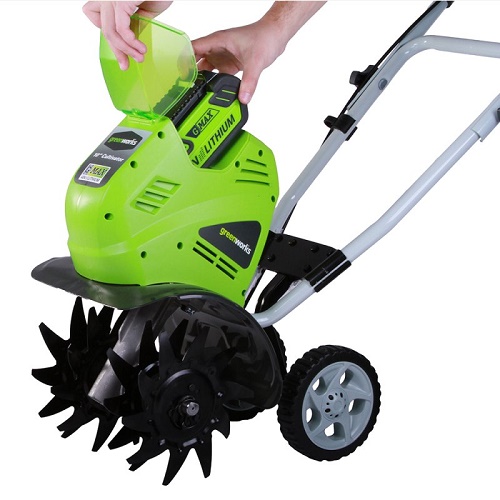
Cultivator Greenworks G-MAX 40V
By weight and power
The separation of equipment on this principle allows you to choose the best unit for their needs.
- Ultralight. Its weight does not exceed 15 kg, and power is about 1.5 hp The average width of the cultivation of the soil is 30 cm. They can loosen the soil layer with a depth of no more than 10 cm. It is a convenient and lightweight cultivator for women. With it, you can quickly and efficiently handle a small backyard area: remove weeds between the beds, take care of flower beds and low-growing plants, carefully loosen the soil in hard-to-reach places.
- Light. The average width of cultivation is 40-50 cm.The depth of soil loosening is from 10 to 15 cm. And the weight is from 35 to 40 kg. Power ratings - from 1.5 to 5 hp The performance of a light cultivator is much higher than ultra-light devices. It is convenient for them to handle both small plots and spacious territories. However, in narrow areas (for example, in the space between the beds) with a width of less than 25 cm, using a device in this category will not work because of its size.
- Average. These cultivators include models from 4 to 6 hp. Their weight ranges from 65 to 70 kilograms. The unit allows you to work the soil up to 25 centimeters in depth, from 80 to 90 centimeters wide. This is a universal garden cultivator (although physically strong men can work with it), and an excellent machine for the cultivation of large personal plots.
- Heavy. As a rule, it is widely used among owners of large land plots. The heavy cultivator is a professional equipment, it is suitable for complex agricultural work. Power starts from 6 hp, weight - from 70 kg and above. Auxiliary equipment usually joins such cultivators.
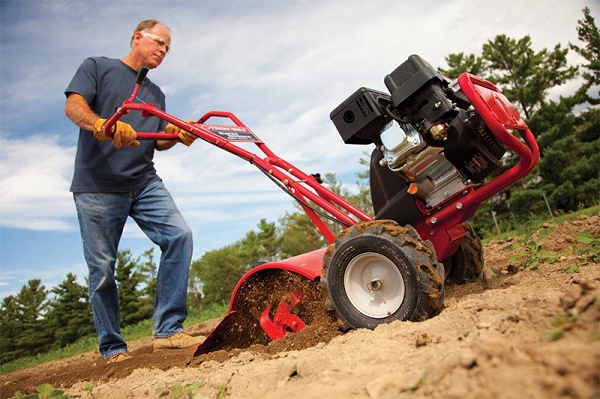
How to choose a cultivator to give
Not all cultivators are universal and suitable for all types of agricultural work. If you want to buy a unit that is best suited for you, we recommend that you rely on the main selection criteria. The fact is that each model of the cultivator has parameters that determine the functionality, performance and service life.
Power
This parameter affects the cultivated area and cultivator productivity. Measured in horsepower or kW. The maximum power output of modern models is up to 7 hp. or 5.2 kW. Estimate the scope of the proposed work and the area of the entire household. In small areas, a unit with a high power rating is not required, whereas plowing a spacious territory will be managed only by a powerful unit.
- To care for the soil in greenhouses, the formation of beds in the country, enough power unit of 1-2 hp or 0.6-1.5 kW.
- For an average area of the suburban area (7-10 acres), the power of 4 hp is more than enough. or up to 3 kW.
- Huge farmers' territories are plowed with the help of 6-7 hp cultivators. or 4-5 kW.
Plowing width
The available width of the cultivated area can vary from 18 to 105 cm. The greater the width of the plowing, the smaller the distance you will need to travel to handle a particular section.
- 18-35 cm is optimal for the care of flower beds, processing of narrow beds in the greenhouse or in the garden. Width of capture no more than 35 cm will provide maneuverability of the device and will allow to pass with it to hard-to-reach spots.
- If you have to cultivate spacious territory and work in the field, choose a unit with maximum widths (from 70 to 105 cm).
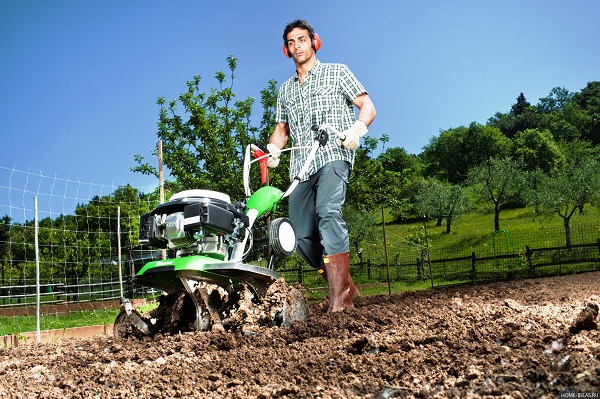
Plowing depth
The quality of loosening or earthing up depends on the depth of processing. Cultivators vary greatly in the depth of plowing within the following range: from 11 cm to 35 cm.
- Models with a minimum plowing depth will prepare the ground for planting crops with a weak root system. Optimally for small beds.
- The average index from 15 to 20 cm will allow loosening and spud hard soil, to prepare it for planting root crops.
- Cultivators with peak values (30-35 cm) are suitable. for processing virgin lands, fight against a large number of weeds, and also for landing of cultures with powerful and strong roots.
Number of speeds
Cultivators differ in the number of speeds and direction of movement. There are four options in total.
- One speed ahead: a standard plowing of a plot takes place, where upon reaching the edge you will need to pull the plow manually. The unit with 1 speed is better mastered by people with excellent physical fitness. Such models are recommended for use in small greenhouses, greenhouses, narrow elongated beds.
- Two speeds: one forward and one backward.. Models with reversing help out when loosening the edges of the site. At any time, you can turn around and continue cultivating the land in the next lane or ridge.
- Four speeds: two forward and two back. With such models you will provide even greater maneuverability and mobility. When rotating the cutters at different speeds (forward and with reverse), you can quickly and effectively shake off the wound roots, long stems and debris. It is optimally suited for the soil of virgin lands and areas where unnecessary weeds are fertile.
- Four speeds: three forward and one backward.. This is a multifunctional cultivator. In essence, he does several useful things at the same time: he loosens the ground at idle or very low revs, cuts grooves and methodically forms small beds under seed material.If the need arises, the device backs up and begins processing the soil along a new trajectory.
Device weight
You can choose a cultivator model based on the weight classification above. The mass of the unit affects its power, functionality, additional features. The weight index ranges from 7 (mini-cultivators) to 93 kg (professional tools).
engine's type
Fuel engine (usually petrol) - not the most environmentally friendly option, since the process produces exhaust gas. In addition, they are very noisy. But if you need to deeply plow the soil, remove powerful weed roots from the ground and grind the compacted layers of earth, this option is for you. Like it or not, but the fuel engine provides maximum performance.
Electrical engine more eco-friendly, but less powerful. Power is supplied from the network or battery.Of the advantages: no noise, low weight, does not require additional maintenance in the form of buying fuel.
Conclusion
The cultivator is an agricultural tool with a wide range of possibilities. It is almost irreplaceable in the fields and vast territories, but at the same time it is suitable for a garden. Choosing a cultivator is not an easy task, it will be necessary to take into account a lot of criteria and conditions for future work. To understand which one is better, review user reviews, documentation, types of cultivators. Focus on the brand and manufacturer, pay attention to the health of the nodes and the absence of defects.

/rating_off.png)








